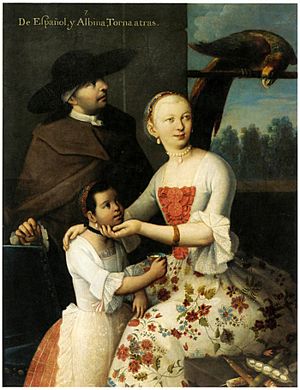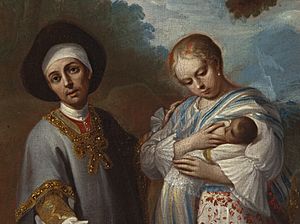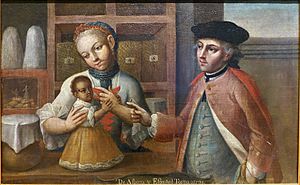Torna atrás facts for kids

Torna atrás (pronounced: tor-nah-TRAS) is a Spanish term that was used a long time ago, in the 1700s. It appeared in special paintings called Casta paintings. These paintings showed people of mixed backgrounds in Spanish colonies.


The term Torna atrás described a person who had mixed European and Native American (Amerindian) family roots. But, they looked a lot like only one of their "original races." For example, they might look completely European or completely Native American, even though their parents were mixed. It was also used for someone whose parents were half white and half "albino" (a term used then for a very light-skinned person of African background).
Contents
Life in Colonial Spanish America
In the Spanish colonies, the term torna atrás meant something like "throwback" or "going back." It could also describe when a child had features that weren't obvious in their parents. For instance, if a white person and a light-skinned person of African background (called albino at the time) had a child, and that child was born with darker skin than the African-descended parent.
The term torna atrás wasn't an official legal category in colonial papers. However, it was often shown in families in the casta paintings of 18th-century Mexico. These paintings tried to show all the different mixes of people.
How People Were Classified
Casta paintings often had lists explaining the different mixes of people. Here are some examples from famous painters of that time. They show how people thought about different family backgrounds.
| Miguel Cabrera, 1763 | Andrés de Islas, 1774 | Luis de Mena, around 1750 |
|
|
|
Torna atrás in the Philippines
The term tornatrás was also used in the Philippines. This was during the time when Spain ruled the Philippines, from the 1500s to the 1800s. It described people who were a mix of different groups. These groups included Austronesian people (called indio), Chinese (called Sangley), and Spanish (called filipinos or insulares if born in the Philippines, or peninsulares if born in Spain). Sometimes, it just meant a mix of Chinese and Spanish family roots.
Famous Torna atrás People
Even though tornatrás first described people with European, mixed-race, and "albino" backgrounds, in the Philippines it often meant something else. It was commonly used for children born from a Spanish father and a mother who was a mix of native and Chinese (a mestiza de Sangley), or a mother who was fully Chinese. They could also be born from a parent who was mixed native and Spanish, and another parent who was mixed native and Chinese.
Most people of the tornatrás group in the Philippines spoke Spanish as their main language. Many of them also became Catholic. Some famous people in colonial history who were considered tornatrás include José Rizal, Andrés Bonifacio, and Manuel Quezon. These individuals played important roles in Philippine history.
There are no official numbers for how many people around the world have tornatrás ancestry today. Because of how history and colonial times worked, it is thought that most of them are found in South America (like Peru, which has many people of Chinese and Japanese background) and the Philippines.
See also
 In Spanish: Torna atrás para niños
In Spanish: Torna atrás para niños
- Castas
- Filipino mestizo
- Miscegenation
- Morisco
- Mulato
- Atavism
- Passing (racial identity)
- Sandra Laing

